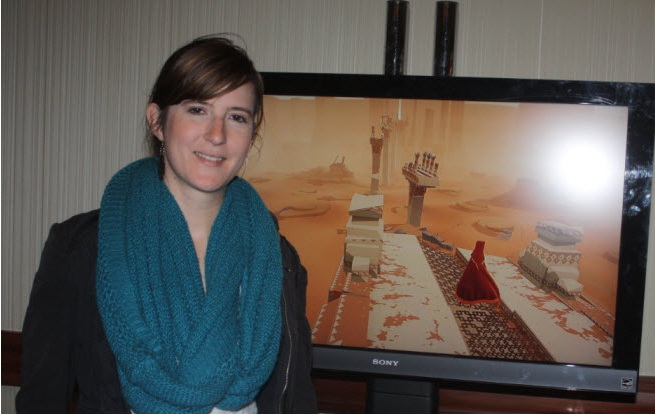 Kellee Santiago is co-founder and president of Thatgamecompany, the Santa Monica, Calif.-based game studio she started with Jenova Chen. After three years of work, the company’s Journey game on the PlayStation 3 will go on sale as a downloadable title on the PlayStation Network on March 13. The game has already gotten accolades from game critics, including a high rating of 90/100 from GamesBeat. In the game, the player goes on a solitary journey across the desert to a distant mountain. The visual effects of the wind and sand are beautiful, and the story is told without any words.
Kellee Santiago is co-founder and president of Thatgamecompany, the Santa Monica, Calif.-based game studio she started with Jenova Chen. After three years of work, the company’s Journey game on the PlayStation 3 will go on sale as a downloadable title on the PlayStation Network on March 13. The game has already gotten accolades from game critics, including a high rating of 90/100 from GamesBeat. In the game, the player goes on a solitary journey across the desert to a distant mountain. The visual effects of the wind and sand are beautiful, and the story is told without any words.
Thatgamecompany’s work has drawn attention because it has avoided violence in games and is steering into emotionally engaging content that very few others in the industry are doing. In doing so, it has become one of the models for innovation among independent game studios.
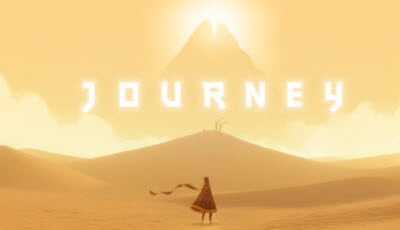 Santiago gave a TEDx talk in 2010 on how video games can be considered art and was challenged on that assertion by critic Roger Ebert, who said that video games can “never be art.” But judging by the outstanding reviews that Journey is getting, Ebert may have to eat those words.
Santiago gave a TEDx talk in 2010 on how video games can be considered art and was challenged on that assertion by critic Roger Ebert, who said that video games can “never be art.” But judging by the outstanding reviews that Journey is getting, Ebert may have to eat those words.
We caught up with Santiago at the Game Developers Conference this week. Here is a transcript of our talk.
GamesBeat: How is your GDC this year?
Kellee Santiago: I helped organize the Indie Games Summit this year, it’s been really great so far. I’ve been happy about that.
Gamesbeat: That seems like a lot of work, a lot of games coming in.
KS: Yeah. I was at TED Active last week too. When the first session started yesterday I thought, “I’m at another conference.” [laughs] “Oh, God.”
GB: I played the game all the way through, and the second time through with my 15-year-old daughter. She remembered Flower.
KS: Oh, wow! Cool.
GB: And my joke was, you know, you guys take too long to make these things. [laughter] Three years to make this one?
KS: Yeah, it’s definitely our biggest endeavor to date. We got up to about 13 people, compared to Flower, which was about seven people over two years.
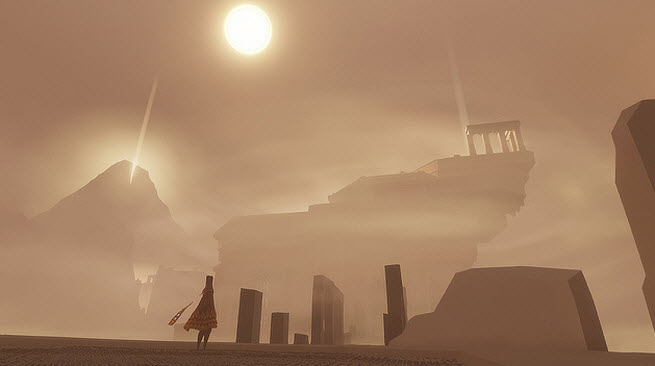
GB: And it was about three hours, is that the gameplay…?
KS: It kind of depends on what sort of player you are, but I think if you go pretty much straight through the experience, it’s two to three hours.
GB: Is that shorter than Flower? I think I remembered Flower being a little longer.
KS: No, that’s what’s interesting. It depends. I know just anecdotally, people who have e-mailed us and such have said their flower experience was around three to five hours. Whereas I can play through it in 45 minutes. Journey takes me usually about 90 minutes, being the super pro player because I know how to go through it.
GB: So what are you guys thinking of with some of the design, when you target a short amount of time that way? Compared to shooting for a five or ten-hour experience…
KS: Well, there’s a couple of things that factor into the length of play. One is, we do want players to have the ability to go through the entire emotional arc in one sitting, so you can really absorb that whole experience in one sitting if you want to. But also, our goal is really to…
GB: Is that like a trip to the movies?
KS: Kind of. Certainly we borrow a lot from Holllywood film structure. Jenova has spoken in the past about the three-act structure that he tries to implement, and the overall emotional arc as well, of Flower and Journey. But also, we’re really searching for an experience that feels right. It’s such an intangible thing, but the flow of it feels appropriate, the contrast and comparison of the emotions from level to level have a good beat. In that way, it’s sort of evaluating it at the level I would compare to an editor, a book editor or a movie editor, where there’s certainly some ideas in mind about possibly the length of the experience, but really what you’re looking for is almost an intuitive, gut feeling to it. That the beats and the movement from beat to beat make sense. That’s our primary motivating factor. As opposed to just a somewhat arbitrary number like five hours, six hours. For me personally, the first Portal game is a great example of that, where it was maybe a two to three-hour experience, but there was nothing additional. In general, it doesn’t feel like there was anything missing, and there was no excess.
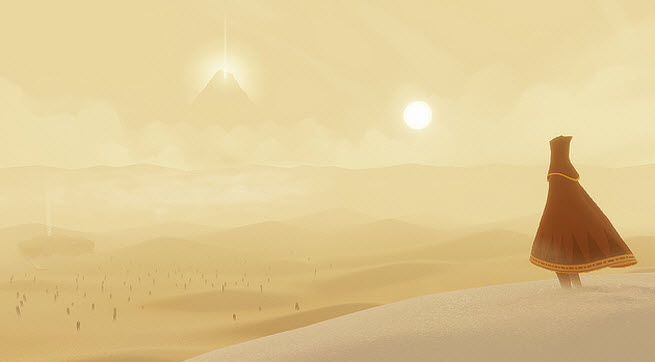 GB: What about some of the other designs? It seems like one of your trademarks is to not really have a game where a player has to learn a whole lot, have a tutorial at the beginning. It’s intuitive.
GB: What about some of the other designs? It seems like one of your trademarks is to not really have a game where a player has to learn a whole lot, have a tutorial at the beginning. It’s intuitive.
KS: Yeah. All of the learning and tutorials we try to embed in the world itself, so that the player is learning and going through a tutorial process, but without us popping up specific instructions or directions on what they’re supposed to do. At the same time our goal is also accessibility, and creating experiences that we think will appeal to a wide variety of people, regardless of their gamer status. Something we learned early on from the student project, Cloud, is when you do that, yes, you get a lot of people who haven’t played games before, and so you have to be cognizant of their background, that maybe they’re not familiar with the usual conventions that we as gamers are so used to that we don’t even realize how much knowledge we’re already bringing to a game.
GB: There aren’t too many answers in it. Why do you press the circle button and … sing, I guess I came to call it? It felt like you were singing. This little symbol comes out. But there’s no explanation. What is that?
KS: The idea was that cloth is a life force in the world, and you’re also made out of cloth, and you can interact with that life force in the world around you, and including another player by this singing mechanic. There’s the very mechanical use of it as far as interacting with cloth and navigating around the world. But then it’s also a communication device.
GB: I didn’t know the person was made of cloth.
KS: Well, it’s left ambiguous, as far as what’s underneath that robe. [laughs]
GB: It seems like the level of interactivity, as well, is very different from other games. In most other games you’re always pressing a button, hitting something or jumping, whereas here you’re occasionally doing that, but you’re mostly just moving around. Did you guys make a deliberate decision about that as well?
KS: Yeah. Again, I think it relates to the process of how we design the tutorials as well, making the interactivity in the game relate to what you’re doing in the world. We tried to make the interactions as intrinsic to the experience as possible.
GB: It’s a simple game but it took you three years to make. It reminds me of how Apple designs products. They labor over different things that make the user experience very simple. It is a minimalist design. And that turns out to be very hard to do. Is that what your experience is?
 KS: That’s absolutely what our experience is. The most elegant solution is also the most complex. I think, because of the simplicity of the final experience in all of our games, people can wrongly assume that one day Jenova woke up and had this whole idea and we just spent all that time trying to execute it. Which is not the case at all. It’s sort of… We have that hint of an idea that we begin with, and there’s a lot of experimentation and prototyping and playtesting, and we go in many, many different directions. Which Jenova and our lead designer Nick Clark are going to speak to at the experimental gameplay workshop.
KS: That’s absolutely what our experience is. The most elegant solution is also the most complex. I think, because of the simplicity of the final experience in all of our games, people can wrongly assume that one day Jenova woke up and had this whole idea and we just spent all that time trying to execute it. Which is not the case at all. It’s sort of… We have that hint of an idea that we begin with, and there’s a lot of experimentation and prototyping and playtesting, and we go in many, many different directions. Which Jenova and our lead designer Nick Clark are going to speak to at the experimental gameplay workshop.
GB: Where did some of that idea come from? What were the influences…?
KS: There’s a couple of different influences that I think most creative endeavors entail. We knew that for the third game on PlayStation Network, that we wanted to do something online. We hadn’t done that before. And we had to take the lessons we’d learned through the process of developing flOw and flower, the single-player experiences, and apply that to the online space. Jenova had been thinking for a while about this idea of an experience where you were on a journey, and that by experiencing different moments and environments with other people who in and of itself was a meaningful connection. To people you don’t know. There was a lunch conversation Jenova and I had at a USC event, where we met a spacecraft pilot who had been on three missions to the moon, piloting the space ships. He spoke to his experience, which was that every mission specialist, the people who get out and walk on the moon, was atheist or agnostic when they went on the mission, but when they came back, sometimes immediately and sometimes not ’til months after, they would suddenly be filled with a sense of spirituality. Jenova’s takeaway from that conversation was that… When you are on the moon, looking back at that blue ball, you’re filled with a sense of awe and wonder, and that sense of awe and wonder, because of all of the resources and technology we have available to us today… We don’t have as much access to it. And maybe that’s a fundamental human experience. Could we provide that experience, give people that opportunity to just have a moment where you feel small?
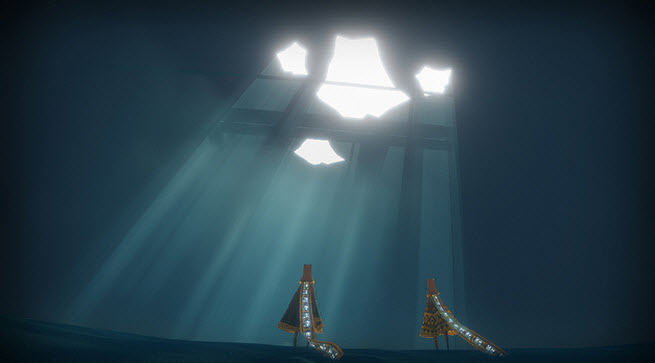 GB: I guess there are different ways to describe the story… I could say you start on a journey toward a mountain, you go through some struggles, and you get there. That could be the whole story. How do you guys describe some of this?
GB: I guess there are different ways to describe the story… I could say you start on a journey toward a mountain, you go through some struggles, and you get there. That could be the whole story. How do you guys describe some of this?
KS: Well, we deliberately left it open-ended, so that regardless of your particular cultural background, your religion, your general perspective on life, there hopefully is an interesting interplay between the story in the game itself and your own story and your interpretation and what you’re bringing to it.
GB: I was a big fan of Stephen King’s The Dark Tower series.
KS: Yeah, me too.
GB: Seven novels into that story, you had the same story. You took two hours to tell it. It took Stephen King about seven volumes.
KS: And that was based on a T.S. Eliot poem, or inspired by the T.S. Eliot poem The Wasteland. So it’s certainly a common theme. It’s a monomyth. We had done research on the hero’s journey, Joseph Campbell‘s research on this fundamental story that seemed to resonate throughout time and space, in human history. And applying that to our game.
GB: I guess you must be hearing some people, like… What kind of interpretations of the game are you heairng from people, from fans? What have they taken as the message of the game?
KS: Well, I think that’s what’s been so overwhelming to me so far, just hearing the response from the press people that have been doing their writeups. Everyone does seem to be taking away a very personal interpretation of what that journey is. Some people interpret it as a process of getting older, and your life journey as you start from not knowing anything, to the challenges you encounter, to growing old. Other people take it as much more… More of a moment in time, maybe a specific recent journey that they’ve been on. Even for all of us, as we sit here after three years now working on the game. Each one of us on the team at some point, or at many times, have commented that, yeah, the game also represents our own journey, and everything that we’ve taken away from the last three years as individuals.
GB: Technologically, it looks really hard to do. The sand seems like it’s real. You guys probably spent a lot of time on that.
KS: Yeah, well, I mean I have to give credit to our lead engineer John Edwards, who’s been with us since the beginning on flOw. He really supports that desire that we have to create experiences that have intrinsic value, and I think when we talk about 3D experiences on a console, the intrinsic value a lot of times comes from just being in this environment, and this place. That’s where we really wanted the idea of replayability to come from, that you would just want to come back and surf on the sand or fly through this one area or encounter different creatures in the world. We took a trip at the beginning of the project to the Pismo Beach sand dunes and really did get a lot of inspiration about how it felt to struggle up a hill and run along the crest of a dune. He really ran with it, he did an incredible job. Even through the last year, I would come into the office and see a new lighting system that he had implemented, or a texture to the sand that just continued to make it feel more and more alive.
GB: Was anything useful to you guys from Flower, the graphics that you worked on for that?
KS: There were some things that did cross over in the wind and fluid style simulations that had been operating. As well as everything that had been learned as far as SPU (special processing unit) programming, flower was the first project where we did that, really, utilizing the SPUs.
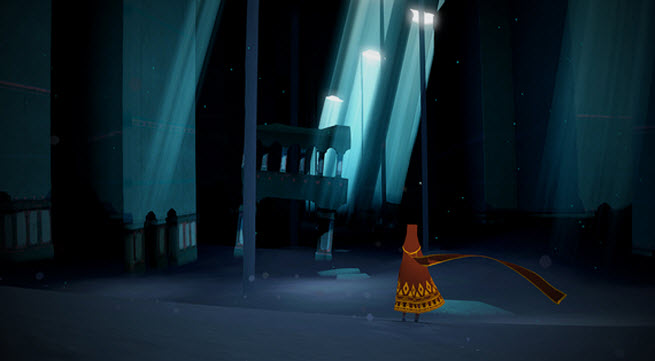 GB: You guys credited something called the “PhyreEngine”? What was that?
GB: You guys credited something called the “PhyreEngine”? What was that?
KS: That is a Sony middleware, graphics middleware, that we use for some of the low-level PlayStation 3 program systems, and some of the animation systems as well.
GB: Did Sony Santa Monica, did they help with that?
KS: Sony Santa Monica is the studio through which we’re published, yeah.
GB: But it was all your work, as opposed to getting help from Sony on that, early in the game?
KS: That’s right. The sound design and music are contracted through Sony Santa Monica, so Steve Johnson, he’s a sound designer at Sony Santa Monica. And Austin Wintory, who did our music on flOw as well and did the music for Journey, he was contracted through Sony Music.
GB: So what did you want from the music, the sound design?
KS: Well, we wanted to build upon the ideas that we had worked on in flOw and Flower, as far as having a very integrated sound and music experience that enhanced the feeling of the place that you were in. Also to set the tone for the player, sort of resetting their mindset. I think when Journey starts and you almost have a kind of drone going in the background, and just the light sound of the wind blowing, it takes you from whatever you were just doing on your PlayStation and really puts you into the world. And in that way, just like the visuals and mechanics, we really believe that all these things work together to create a holistic experience, to put you in a different state of mind.
GB: Had you worked in something definite about not putting words into it, at the very beginning?
KS: A couple of different decisions behind not using text or language came into play. One is, we’re not writers. [laughs] Just on the level of trying to leverage the skills and talents our team does have, we didn’t want to attempt to write some grand story and just fall hilariously short of what a really gifted writer is able to present. But also, it feeds into that desire to leave it open-ended. I think we really try and shy away from being too specific about the who, what, when, and where, so that players can put themselves inside the story.
GB: It seems like it magnifies the importance of the music and the environment, for how you feel.
KS: Absolutely.
GB: It’s cold, there’s dark music playing, you just feel it.
KS: Yeah. And we definitely have a different process with music and sound than other games have. We incorporate our sound designer and composer from the very beginning, from the very first prototype, because we do feel like it absolutely impacts the state of mind that the player is in, and therefore impacts the playtesting results.
GB: If I had any criticism, I’d say that it could have been more interactive. As a gamer, there could have been more things to do. But then I also reconsidered that. It could have been a boring game, to me, if it were ten hours long. But at two, two and a half, three hours, you don’t get tired of what you’re doing in the game. I think if you were exploring one thing after another after another, then you’d start repeating a lot of the experiences. It’s interesting to me that what could be very fun at two hours could be very boring at ten.
KS: Sure. I think something as interactive as Skyrim would be super overwhelming in two hours. [laughs]
 GB: But the level of interaction fits the length of the game, is kind of what I was going at. If there were more interesting things that you do, that… It would start looking like a lot of other games, too.
GB: But the level of interaction fits the length of the game, is kind of what I was going at. If there were more interesting things that you do, that… It would start looking like a lot of other games, too.
KS: Yeah. I feel like it’s not a very… It seems like it’s not poetic or sexy to talk about the resource and technical limitations that you have on any given game project, but to me, I think that’s… When I see a successful game experience, it’s because all of those things have been taken into account, that design isn’t operating in a vacuum of just… “Here’s the experience, now go make it.” It is a very iterative process, sketching out designs, prototyping them, and part of the prototyping process is playtesting and finding out if it’s resonating with our players in a way that we want it to. But also prototyping to understand, well, what would it take to do this? What are the pros and cons of this? We don’t want to… Because we’re out to create a very complete experience when we finish, we don’t want to take on too many features that will then dilute or water down that experience in the end. Even though there may be all these different things to do. But I think… These are choices that any game has.
GB: I think Jenova has mentioned to other people that you might consider going beyond the PSN, beyond PlayStation 3, and go to other platforms?
KS: Yeah… It was kind of taken out of context. Because we’ve been really focused on launching Journey, we have the launch on PlayStation Plus today, and then next week the world at large. We’re going to see that through first, and then figure out where that takes us.
GB: There’s a bigger mass market out there, waiting for a game like this. Putting it on the PlayStation 3 from the get-go means you’re going to get a certain kind of gamer. By contrast, someone on Facebook has access to every kind of person on earth… It’s interesting to see what would happen if you created an experience for this larger… It would certainly change the accessibility…
KS: Sure. It would change the experience as well. The fact that we’ve known from the beginning on our last three games that we were going to be on PlayStation 3, that shaped the decisions that we made. Of course the decisions that we made about technology, but also who our audience is, and that all plays into the final experience. We get a lot of questions about porting to even other Sony platforms like the PSP or the Vita, but for us, when we’re making that… We’re making the experience, which may be the first experience of it, but we’re taking into account that specific platform. There are a lot of design ramifications that would occur before we considered multiple platforms. I think it would be a very different experience if we went that way.
GB: Are you contemplating being a different kind of company at all? Are you going to stay at the size you are…? It seems like you have a lot of options. It’s like watching id Software and Epic. id stayed smaller for a much longer time than Epic did, Epic expanded and wound up being like 600 people now. Whereas id never really grew like that, they just made their games once every three or four years. It’s interesting to have those options.
KS: Yes… [pause, awkward laughter]
![]() GamesBeat 2012 is VentureBeat’s fourth annual conference on disruption in the video game market. This year we’re calling on speakers from the hottest mobile, social, PC, and console companies to debate new ways to stay on pace with changing consumer tastes and platforms. Join 500+ execs, investors, analysts, entrepreneurs, and press as we explore the gaming industry’s latest trends and newest monetization opportunities. The event takes place July 10-11 in San Francisco, and you can get your early-bird tickets here.
GamesBeat 2012 is VentureBeat’s fourth annual conference on disruption in the video game market. This year we’re calling on speakers from the hottest mobile, social, PC, and console companies to debate new ways to stay on pace with changing consumer tastes and platforms. Join 500+ execs, investors, analysts, entrepreneurs, and press as we explore the gaming industry’s latest trends and newest monetization opportunities. The event takes place July 10-11 in San Francisco, and you can get your early-bird tickets here.
VentureBeat's mission is to be a digital town square for technical decision-makers to gain knowledge about transformative enterprise technology and transact. Learn More
